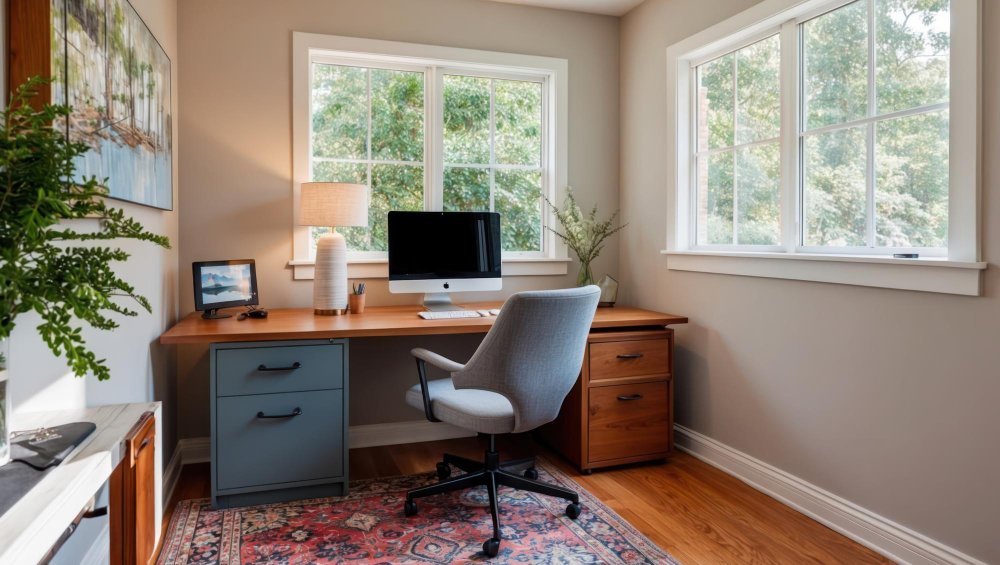In today’s world, a dedicated home office isn’t a luxury — it’s a necessity. Whether you’re running a business, managing remote work, or just want a quiet spot to focus, a well-designed office can improve productivity, reduce stress, and add serious function to your home.
But here’s the catch: not all home offices are created equal. What you need is a custom home office — a space that works the way you work. Done right, it’s clean, efficient, and tailored to your routine.
Let’s break down what it takes to build a smart, professional-grade home office — the Bryan Baeumler way.
1. Function First: What Does the Space Need to Do?

Start by defining your work habits. Do you take video calls all day? Need space for dual monitors? Meet with clients? The function should shape the form — not the other way around.
Ask yourself:
-
Do you need storage for files, tech, or inventory?
-
Will this be used by more than one person?
-
Do you need separation from household noise?
✔ Tip: Write a short list of daily tasks. Design around those needs.
2. Choose the Right Location
Where your office goes matters more than how big it is.
Ideal spaces:
-
A spare bedroom with natural light
-
A converted den or basement nook with privacy
-
An ADU or garage conversion for full separation
-
Even a hallway workstation with built-in cabinetry (if space is limited)
Avoid placing desks near high-traffic zones or TV noise. Privacy = productivity.
3. Layout: Keep It Simple, Keep It Smart

Your layout should do three things:
-
Prioritize natural light without glare
-
Avoid clutter and distraction zones
-
Place essentials within arm’s reach
The work triangle isn’t just for kitchens. Think: Desk – Storage – Lighting. Position your chair to face the door or window, not a wall — it reduces fatigue and increases comfort.
✔ Tip: Leave at least 36″ of clearance behind the chair to move freely.
4. Storage: Built-In Over Bulky
Clutter is the enemy of focus. Use smart storage solutions that blend in:
-
Floating shelves for vertical storage
-
Wall-mounted cabinets to free floor space
-
Drawer systems hidden under the desk
-
Cord management built into the design
Go for streamlined finishes — matte white, wood veneer, or flat-panel fronts. This keeps the space calm and distraction-free.
5. Materials Matter

Durability and ease of maintenance should guide every choice:
-
Desk surface: Laminate or solid wood with a matte finish
-
Flooring: Luxury vinyl, engineered wood, or durable low-pile carpet
-
Paint: Satin or matte finish in neutral, low-stimulus tones
-
Chair: Ergonomic, adjustable, and supportive — this is a non-negotiable
✔ Tip: Avoid high-gloss finishes — they reflect light and create visual clutter.
6. Electrical & Tech Planning
It’s not the glamorous part, but it’s what makes the space work. Your custom home office should include:
-
Sufficient outlets (especially behind and under the desk)
-
Hardwired internet or strong Wi-Fi access
-
Cable management grommets and power bars
-
LED task lighting with dimming capability
Install outlets in cabinetry if possible — keeps things clean and cords off the floor.
7. Final Touches (Optional, Not Extra)
While this is a minimalist setup, small details add polish without clutter:
-
A wall calendar or whiteboard for quick planning
-
A single piece of art that keeps the space visually balanced
-
A plant or soft-texture object to warm the room
-
Acoustic panels (if you’re in a noisy household)
✔ Tip: If it doesn’t serve a purpose or bring calm, skip it.
Final Thoughts: Simplicity Is Strength
A custom home office should feel like a space built for action, not decoration. Done right, it becomes your command center — organized, quiet, and free of distractions.
Whether you’re planning a full build-out or refreshing a forgotten corner, use clean lines, durable materials, and a layout based on logic. It’s not about more. It’s about what works.


